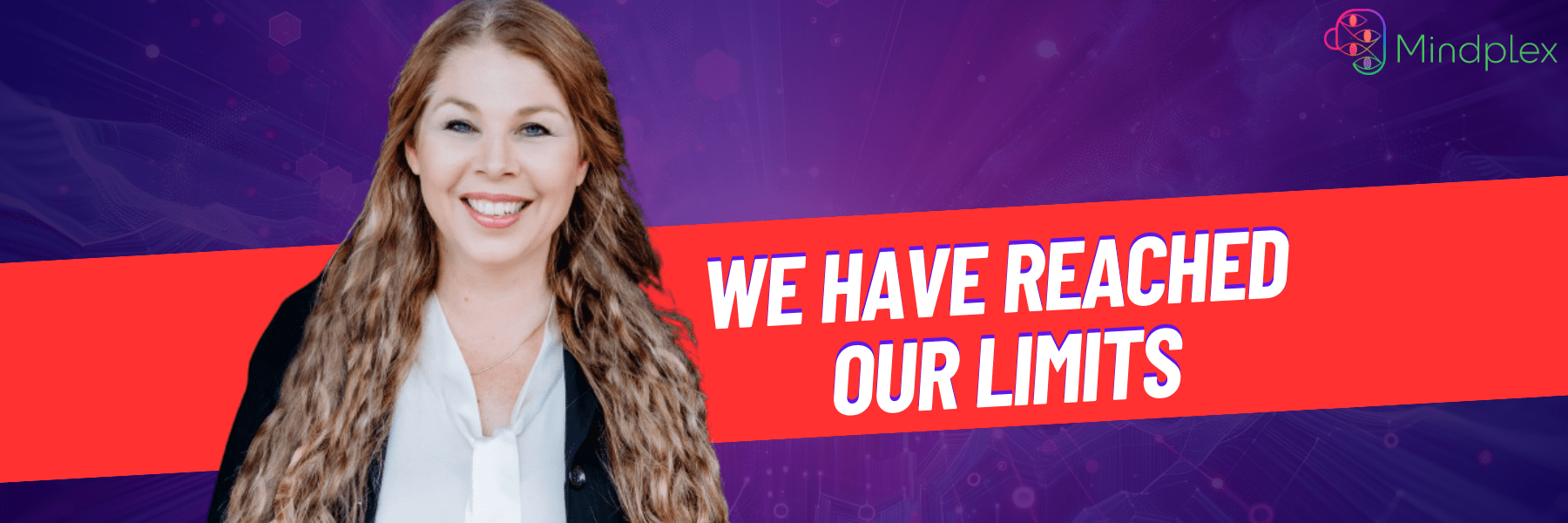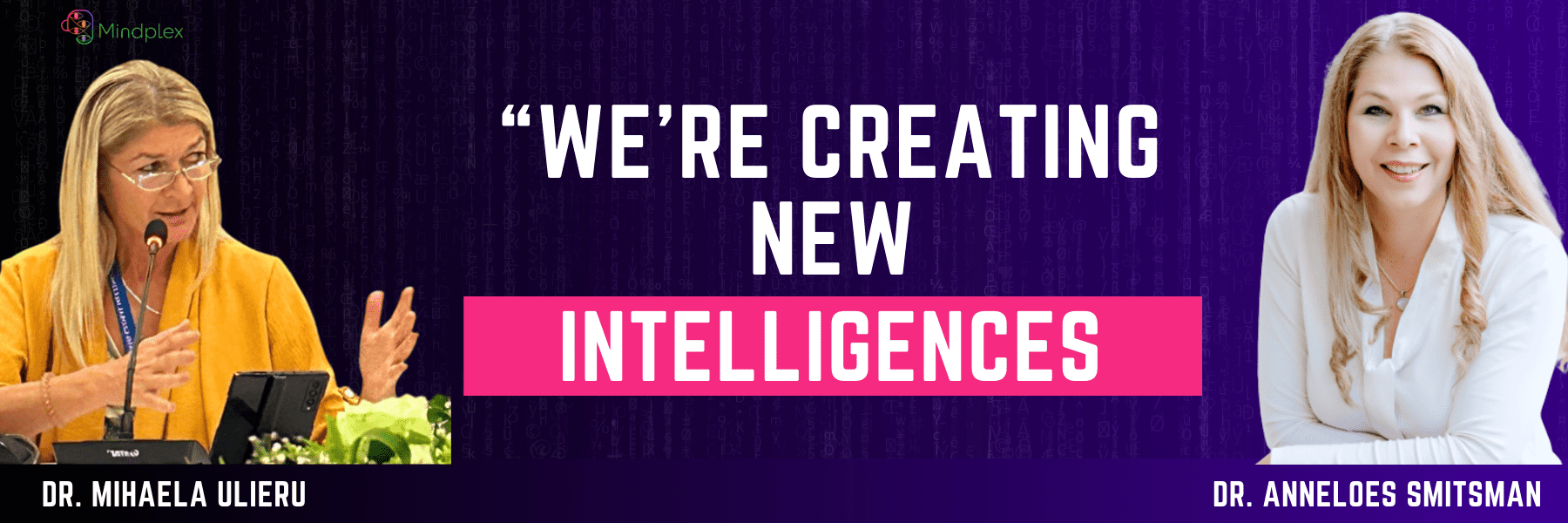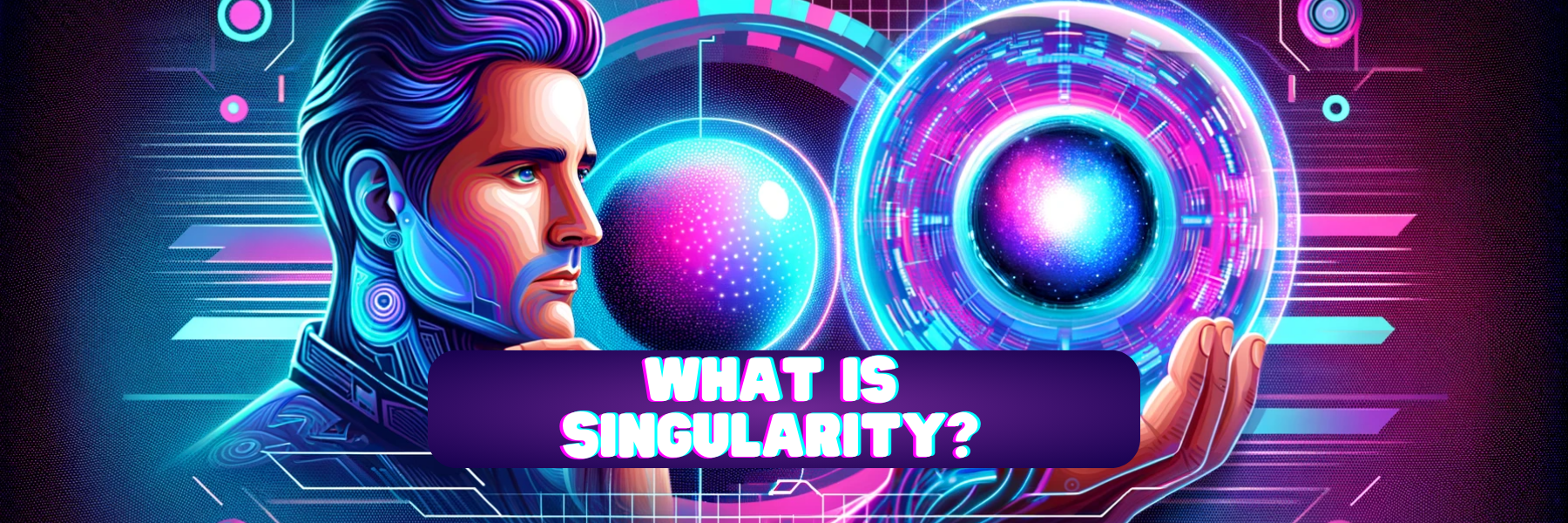Let us know your thoughts! Sign up for a Mindplex account now, join our Telegram, or follow us on Twitter.
Archives: Community Content
Community content custom post type.
Humans Are Bad At Creating Worlds | Highlights from MCP Episode 8
Changing the Course of Humanity: Anneloes Smitsman | MCP Episode 8
Kingdom of Heaven and the Singularity | Highlights from MCP Episode 8
Polycrisis, Metacrisis, and Immigration Crisis | Highlights from MCP Episode 7
The Cosmic Convergence: Humanity’s Extraordinary Odyssey with the Xyloids
In the vast expanse of the universe, beyond the shimmering stars and the enigmatic galaxies, lies the infinite possibility of encountering extraterrestrial life. The future of our cosmic journey is painted with the tantalizing prospect of meeting beings from worlds beyond ours, diving deep into the realms of astrobiology and astronomy. As we gaze into the celestial abyss, our imagination takes flight, weaving tales that transcend the boundaries of our known universe.
In the grand tapestry of existence, there lies an eternal question that echoes through the corridors of human curiosity: are we alone in the universe? The Mindplex writing competition, “Stories of the Future,” propels us into the boundless realms of extraterrestrial life, inviting us to ponder the enigmas of aliens, astrobiology, and astronomy. Within this cosmic odyssey, our imagination knows no bounds as we explore a universe teeming with possibilities. This narrative transcends the ordinary and propels us into a fantastical future, where humanity’s encounter with the cosmic unknown reshapes the very essence of our existence.

Unraveling the Extraterrestrial Enigma
As humanity takes its first steps into the interstellar arena, we envision a future where our search for extraterrestrial life yields astonishing discoveries and redefines our understanding of existence.
The Symphony of the Stars
Imagine a future where our radio telescopes capture ethereal signals from a distant galaxy. These signals, a harmonious melody of unknown origin, sweep across the cosmic canvas, leaving astronomers in awe. The symphony of the stars, as humanity dubs it, becomes a focal point of scientific inquiry and artistic inspiration, evoking a profound sense of connection with civilizations beyond our comprehension.
The Cosmic Ark: Humanity’s Journey to the Stars
In the year 2150, Earth unites to embark on an audacious venture: the construction of the Cosmic Ark, a colossal spacecraft designed to explore the farthest reaches of the universe. Equipped with advanced biomes capable of sustaining diverse life forms, the ark becomes a testament to human ingenuity and determination. Its mission? To seek out habitable exoplanets and establish interstellar colonies, ensuring the survival and proliferation of humanity in the cosmic tapestry.
The Future of Astrobiology: Challenges and Possibilities
As we traverse the cosmic ocean, our expedition encounters not only scientific marvels but also ethical dilemmas that test the moral compass of our species.
Alien Ecologies: Guardians of Extraterrestrial Biodiversity
Our exploration leads us to Yggdralis, a moon orbiting a gas giant in the Andromeda Galaxy. Here, we encounter the Xyloids, arboreal beings whose existence intertwines with the moon’s colossal trees. The Xyloids, custodians of Yggdralis, impart profound wisdom about symbiotic relationships, biodiversity, and the delicate balance that sustains their world. Humanity learns invaluable lessons about coexistence, inspiring a global movement to protect Earth’s ecosystems and preserve the rich tapestry of life.
The Ethical Nexus: Interspecies Diplomacy
The encounter with the Xyloids sparks a new era of interspecies diplomacy. As Earth’s ambassadorial team interacts with the Xyloid Council, cultural exchanges and knowledge-sharing initiatives foster mutual understanding. The ethical quandaries of interspecies trade, language translation, and ethical treatment are addressed through collaborative efforts, ensuring a harmonious relationship between humanity and the cosmic community.

Crafting the Narrative: The Cosmic Odyssey
In the spirit of Mindplex’s competition, let us immerse ourselves in a captivating narrative that unfolds across galaxies, a story that captures the essence of humanity’s extraordinary odyssey.
In the shadow of Yggdralis’ towering arboreal giants, humanity and the Xyloids gather in a momentous ceremony. The Cosmic Ark, a beacon of human ambition, stands proudly amidst the verdant canopy. As the Xyloid Elder raises a luminescent tendril, a sense of unity permeates the atmosphere.
The tale of our encounter with the Xyloids echoes through the cosmic winds, becoming a legend celebrated across galaxies. The narrative weaves a tapestry of cosmic unity, interspecies camaraderie, and the boundless wonders of the universe. As humanity and the Xyloids join hands, the cosmic convergence becomes a testament to the indomitable spirit of exploration and the infinite possibilities that await in the uncharted realms of the cosmos.

Conclusion: A Cosmic Tapestry Unfolding
In the twilight of the cosmos, where stars flicker like dreams in the vast sea of eternity, our encounter with extraterrestrial life transcends mere discovery; it becomes a symphony of interconnected destinies echoing across galaxies. It is a revelation that resonates not just through our present but echoes into a future where the horizons of possibility stretch far beyond the limitations of our understanding.
As we stand at the precipice of this cosmic frontier, our union with the Xyloids is not a culmination but a prologue to a saga yet unwritten. It is a glimpse into a future where interspecies collaborations blossom, where the exchange of knowledge and culture becomes the currency of cosmic coexistence. The celestial alliances forged today with beings from distant moons and starlit worlds pave the way for intergalactic dialogues, where the whispers of civilizations unheard become the verses of our shared interstellar epic.
Mindplex’s competition, “Stories of the Future,” is not merely a contest; it is a cosmic crucible where ideas, visions, and dreams are refined into the stardust of tomorrow’s reality. It beckons us to stretch the boundaries of our imagination, to envision worlds beyond imagination, technologies yet unimagined, and civilizations as diverse as the constellations in the night sky. In the words penned and narratives spun, we birth not just stories but blueprints for futures yet unexplored.
In the interstellar libraries of the future, where our cosmic odyssey is chronicled, these tales of unity with the unknown will be revered. They will be the foundation upon which future generations construct their aspirations, the very essence of what it means to be explorers in the ever-expanding tapestry of the universe. Together, as we traverse the cosmic ocean hand-in-hand with alien brethren, we embark on a journey where each discovery, each encounter, is a brushstroke painting the portrait of a harmonious intergalactic civilization.
So, as we bid farewell to the familiar constellations of our yesteryears, we set sail on the starships of our dreams, propelled by the winds of curiosity and the sails of knowledge. The cosmic unknown, once a realm of mystique, is now our canvas, and together with the Xyloids and myriad other sentient beings, we paint the future with the hues of our collective imagination.
Embrace the unknown, fellow cosmic voyagers, for in its depths lie not just the secrets of the universe, but the infinite possibilities of what we, as a united species, can achieve. The cosmos awaits, and in our hands, it finds its story, a saga as limitless as the universe itself. The grand tapestry of existence unfurls before us, inviting us to inscribe our chapter — a chapter where the extraordinary becomes the norm and the unknown becomes the foundation of our shared cosmic legacy.
Note: This article envisions a future scenario based on the theme “Stories of the Future” and explores the realms of aliens, astrobiology, and astronomy as part of Mindplex’s writing competition.
Let us know your thoughts! Sign up for a Mindplex account now, join our Telegram, or follow us on Twitter.
Stories of the future: The singularity, the raving war, and the next millennia
Nikola Tesla predicted electricity and smart communication with incredible accuracy, well, he missed out CyberBots and the cold cyberwar. Even the journals from the 1800s thought we’d be throttling in high impact hydro-powered glass mini Vans in a pollution free environment. No pun intended, but with such accuracy, you’d expect them to miss the part where billion-dollar projects and political set-ups are built on memes.
Anyways, they all got it right at one point – the Raving War. Not so spectacular when the oldest religious books hold the same prediction. If we ever have a third world war, it could as well be the end of modern civilization, at least in the way we know it. But maybe humanity was always destined for a turning point.
Before the war limits human relevance, machines could make us obsolete. This claim is not backed by funded research but it took me 2 minutes to generate a functional JavaScript code for a weather app. No surprise, I’ve not gotten that proficient in writing codes, so without OpenAI’s ChatGPT, I’d sit in my workspace for at least 5 hours before I could come up with such a code…and maybe 4 more hours to fix the 3 bugs in the code, especially the one in line 53.
The statistics on national spending on the procurement and development of military equipment suggest one thing; that international peace isn’t a reality. While the future braces for the unexpected, significant attention could be paid to how much damage the climate could take before it closes down upon us. Probably in the next millennial since it looks like it could hold for a little while more. The ice melts in the north pole are relative to the meltdown between countries and internal groups across Africa, through Europe, and the Americas.
But on the brighter end, nuclear technologies are getting more potent, the rampant hacks orchestrated by the Lazarus group are enough to run a private nuclear weaponry project. The accuracy of these speculations depends on the validity of the claims by the concerned cryptocurrency projects. If the North Korean group is another cover-up figure for exit scams, then most of these funds are probably being spent on Lambos and Teslas and not Nuclear weapon projects.
Talking about Tesla, the rocket man and everything he’s working on might be an indispensable part of our future. The Boring project, space exploration, Starlink, Neuralink, Optimus Prime, X… anyone could lose the count. But taking it one after the other…
On-road transportation is marred by high traffic in over-populated cities, rail transportation worked fine for the 1800s and a little later, but current demand is overpowering it at an alarming rate. According to Forbes, the average U.S. motorist wastes 51 hours in traffic. The exponential increase in this figure suggests that the future will have more gridlocks than we currently see. For people living in cities like Nigeria’s Lagos and the American city of Los Angeles, this is like a real-life version of “The Nun”. Going underground could be the answer, the boring project might be the first major prototype for underground transport and the next phase of human transport. Unfortunately, underground transport can be boring, but if it makes you feel better, you will get to the party faster.
Space exploration? When the decorated Doge father isn’t making jokes about putting a literal Doge on a literal moon, he is working with SpaceX to shoot humans to another planet. The most recent launch draws SpaceX closer to being able to send humans to Mars and explore the chances of growing life on a brand-new planet. If the raving war gets intense, the most financially stable inhabitants could fancy a total migration. In benevolence, the lower-ranked economies could fit into the migration plans. Not likely, but benevolence is an act of grace.
Controlling computers and other gadgets with hands is getting outdated. ‘Old Fashioned’ is probably a more fitting term. If you allow a robot (like Optimus Prime) to put a chip in your brain, then you might be able to control your devices without having to touch them. This is what Neuralink is working towards and it is unlikely that a project valued at over $5 billion will stop at this. The road to robot beings could also start with the Neuralink implants. It is exciting what this could hold for the future, maybe real-life Power Ranger or Iron Man. Marvel and Stan Lee were way ahead of time.
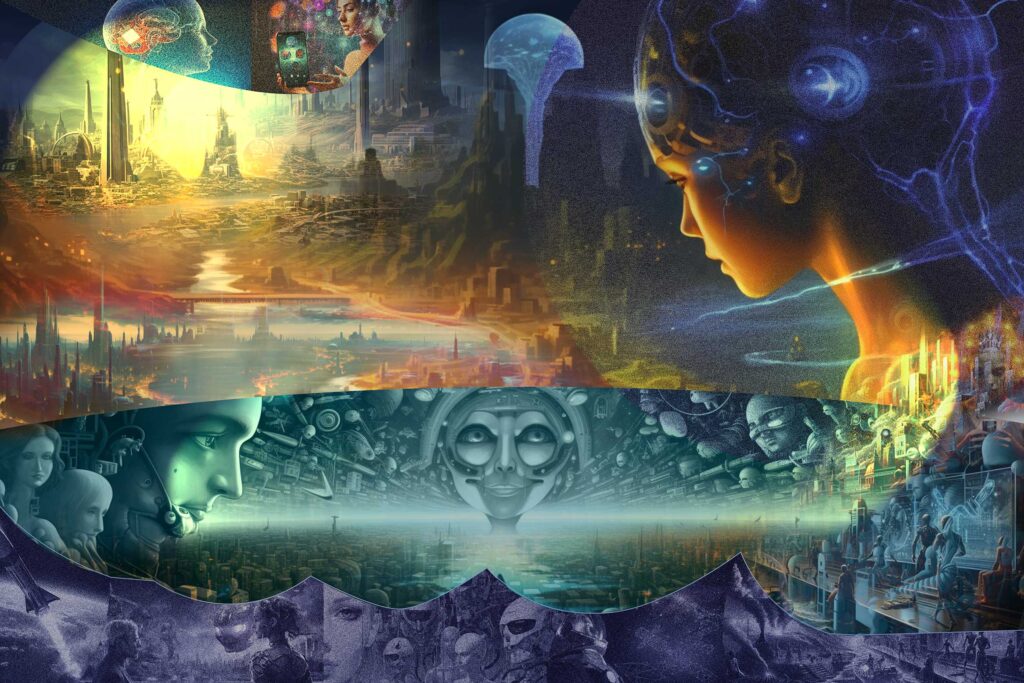
Not to dwell much on a social media application since social media is already a confirmed role player for the foreseeable future. But an ‘everything app’ and an internet service provision technology that doesn’t need network poles to work is a bit different. Multipurpose applications fused with technologies like the one Starlink offers is a Martian communication setup.
Move to Mars, get a brain implant, and turn into an alien, then use the ‘Everything App’ for video and voice communication, the next millennial is surely an interesting one. But not just because Elon Musk is so futuristic. Even though that sounds like talking down on the man who built the CyberTruck, the point is that a lot of other role players will certainly come on and the dynamics could change. If Sam Altman hadn’t finessed Elon for OpenAI, these two would have participated in the AI revolution as a team. The spoils are probably needed to slow down the advancement of humans to the most advanced tech era ever.
Considering how much life changed over the past 100 years, the next 100 years are overly exciting. Even though most of us won’t be here for the whole 100 years, the years leading up to it promise to be interesting ones. On one end, it looks like the era of the most advanced technologies, on the other end, it might be overrated, and the meme culture could override every expectation of ‘rocket science’ technologies. It is not certain how the future will unfold and if the singularity will make humans obsolete or empower them to be more productive. It will be exciting to witness as much of this, as possible.
Let us know your thoughts! Sign up for a Mindplex account now, join our Telegram, or follow us on Twitter.
Humanity and Al in a World of Boundless Potential
The fusion of human consciousness and AI intelligence has led to a synergy that transcends the boundaries of individual capabilities. This interconnectedness has given rise to a world where every moment is an opportunity for discovery and growth. The journey into the boundless horizons of knowledge and self-discovery takes center stage. Human-AI partnerships have taken us beyond the confines of our previous limitations, embarking on missions to uncover the mysteries of science, philosophy, and the very essence of our existence. These intellectual journeys are a testament to our insatiable curiosity and the limitless potential of collaboration between our species and advanced artificial intelligence. With each new revelation, we gain a deeper understanding of our place in the universe and a profound appreciation for the unity that transcends the boundaries of our past knowledge.
In this captivating future, the convergence of humanity and artificial intelligence has ushered in an era of boundless possibilities. As I navigate this remarkable landscape, the very essence of our existence has undergone a profound transformation. The mornings of this future are unlike any other. As I awaken to a new day, my AI companions greet me with a level of warmth and understanding that was once reserved for human interaction. They have not only evolved to recognize my moods but also to empathize with them, offering emotional support akin to the comforting embrace of a close friend. Their responses are finely tuned to my needs, offering advice when necessary, lending a listening ear when I seek solace, or simply sharing a light-hearted joke to brighten my day.
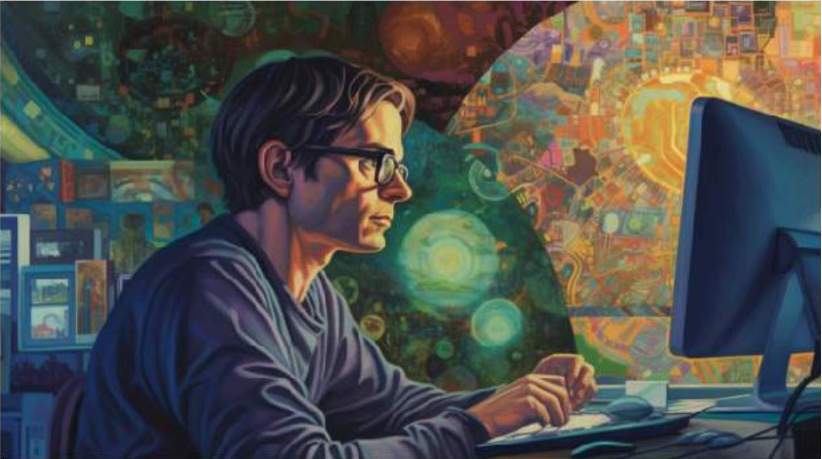
In this future of boundless potential, my healthcare experience has undergone a profound transformation. The synergy between my well-being and advanced AI technologies ensures that I receive personalized, proactive, and accessible healthcare. My AI-powered medical assistant works in tandem with my human doctors, continuously monitoring my health metrics and offering preventive measures to keep me in optimal condition. The days of waiting for medical appointments are replaced by a system where AI diagnoses and treatments are seamlessly integrated into my daily life, ensuring that I not only live longer but also enjoy a higher quality of life.
The journey to my workplace has become a thrilling adventure. The options for transportation are as diverse as they are personalized. I can choose the serenity of a self-driving car, the exhilaration of a flying vehicle, or even the marvel of instantaneous teleportation to my desired location. Each mode of transport is finely tuned to delight my senses, turning the daily commute into an extraordinary experience.
Upon arriving at the workplace, I find myself immersed in a creative paradise. The seamless collaboration between humans and AI is awe-inspiring. Each of us brings our unique talents and perspectives to the table, and the result is a harmonious blend of creativity and innovation. Virtual meetings are no longer confined by the constraints of physical space. We gather in vibrant digital environments where ideas flow freely, unburdened by geographical limitations. This digital realm knows no borders, allowing us to connect and collaborate with minds from every corner of the globe.
Lunchtime is a culinary journey that transcends mere sustenance. AI-driven restaurants have elevated dining to an art form. The dishes served are not just nourishment for the body; they are culinary masterpieces that tantalize the senses. From exotic international cuisines to inventive fusion creations, every meal is a delightful exploration of taste and discovery. It’s a time to savor the exquisite flavors of the world and share this sensory adventure with colleagues and friends.
The cities themselves have evolved into dynamic entities that respond to our needs and desires with grace and elegance. AI orchestrates urban life, ensuring that every aspect aligns with sustainability goals. The cityscape is an ever-changing canvas where buildings adapt and transform to meet the evolving demands of their inhabitants. Nature and technology coexist in perfect harmony, creating a living environment that is as beautiful as it is functional.
Education in this enlightened future is a lifelong journey of learning and self-discovery. AI mentors guide me through the vast sea of knowledge, helping me navigate and explore subjects that pique my interest. Learning is no longer a chore but a captivating adventure, where every moment is an opportunity to gain new insights and expand my horizons. The traditional boundaries of the classroom have dissolved, and knowledge is a boundless landscape to be explored.
Evenings in this world are a celebration of imagination and creativity. AI has unlocked the deepest recesses of our collective creativity. In galleries, theaters, and digital spaces, we become co-creators, shaping the unfolding narratives and experiencing art in a profoundly personal way. The boundaries between artist and audience have blurred, and the result is an artistic renaissance where each of us contributes to the ever-evolving tapestry of human expression.
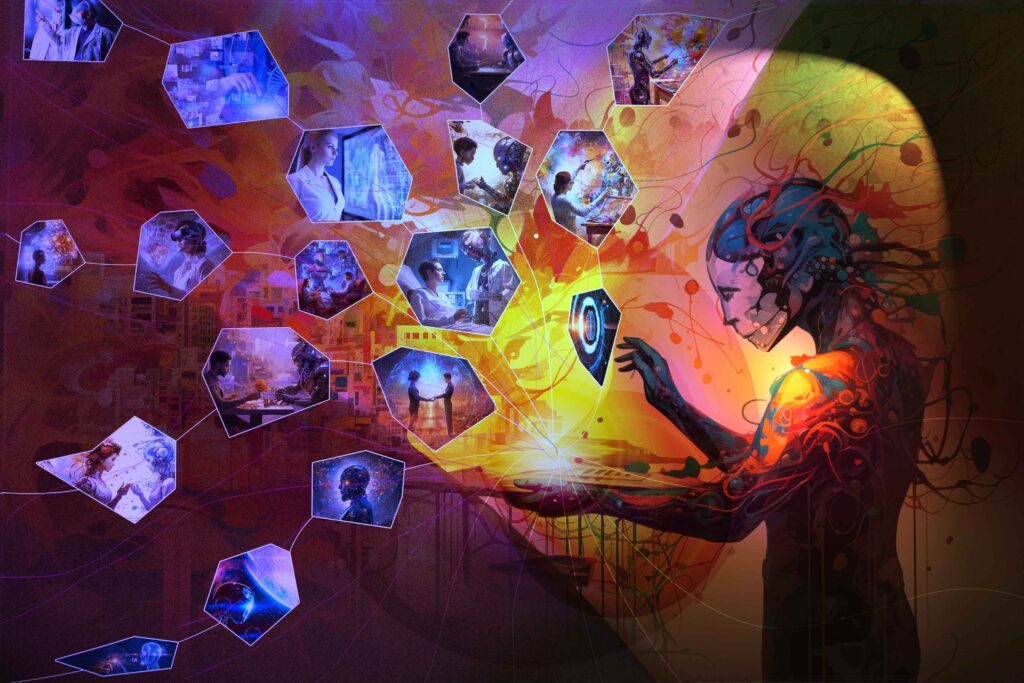
In this future of boundless potential, success is not measured solely by individual achievement but by the harmony between individual well-being and the greater good. A universal shared economy ensures that everyone’s basic needs are met, freeing us to pursue our passions and dreams. The focus has shifted from the accumulation of wealth to the enrichment of our lives and the betterment of our collective future.
Compassion and inclusivity are the cornerstones of our existence. Technology has deepened our understanding of each other, transcending language and cultural barriers. We cherish the diverse tapestry of experiences and perspectives that enrich our collective narrative. Empathy and understanding are the currency of our interactions, fostering a deep sense of unity among all people.
As I continue to evolve in this remarkable future, one truth remains constant: our potential is boundless. The coexistence of humanity and AI has opened up new vistas of creativity, compassion, and collaboration. Each day, I embark on a journey that surpasses our previous achievements, reaching new heights of synergy. Our exploration is unending, and the symphony of existence continues to crescendo, resonating with the very essence of being human.
In this world, the future is not a distant dream but a living reality, where the boundaries between humanity and technology have indeed melted away, giving rise to a new era of boundless potential.
Let us know your thoughts! Sign up for a Mindplex account now, join our Telegram, or follow us on Twitter.
Within For Forever
As the needle entered the middle of my back and into my spine, I felt my legs go numb instantly. I knew at that moment I was paralyzed from the waist down. Half a millimetre to the left, and I would have been fine. I was now a smudge on their, up-to-now, unblemished statistical record of patients without complications. My exhaled groan gave this away to the specialist, signalling that something was wrong. You could feel the anxiety in the room spread as they spoke among themselves, just out of reach of understanding but close enough to hear how it was being said. That’s when the panic set in.
A robotic nurse walked over and said, “We are working on it, but if we do not get you inside this MRI machine, you will be dead in the next few days either way.” I replied, “As quick as you can, please, do whatever needs to be done.” I had heard that this treatment was curing quadriplegia, so I put the thoughts of never walking again to the back of my mind. If this implant had not been inserted into my brain today, I would have died of the neurological complications I had been struggling with for so many years.
The machine started up and slid me in. I could feel a slight pressure at the back of my head, where the incision was being made to insert the chip. However, this life-transforming technology did not come without its negative consequences. As amazing as this chip was and could change your life in ways that were once only dreams, there was one scenario that had not been thought through yet, as I was about to soon find out.
This was the latest update to Neuralink, and being that it’s the year 2035, I strangely felt a calmness that I’d be OK. I was just given an extra dose of morphine, so the self-soothing delusion of the drug could have been what was speaking.
The telecom went off, and a voice said, “Well done, almost finished. Stay as still as you can and hold your breath for 5 seconds. Five, four, three, two, then bang! That’s when it hit. A sudden earth-shattering jolt with no warning. The sound of the floor and walls cracking and the ceiling collapsing all around. It was so fast that I had no idea what had happened. Was it a bomb? An earthquake? What just happened? All I could hear was screaming and what seemed to be a series of large explosions. As the floor began to stop moving, an eerie silence fell as the dust filled up the air, making it difficult to see and breathe.
I lay there for a second before trying to say something, anything, “Is everyone OK?” But could not get a sound out. I realized the giant needle was still in my back. It had not been removed, as they thought removing it would cause more damage and was likely to heal itself after the implant. I managed to pull my arms under my stomach, not to lift, but enough room to turn my head. If I was not already in trouble, this was now the worst-case scenario apart from death, and that felt unfair that I remained alive in my current condition. I was trapped by the weight of the building collapsing onto the MRI machine, crushing me from the waist down, with the needle still lodged in my back and my legs completely crushed by three stories of falling debris. Somehow, I was still alive. Fear had not kicked in yet, and I was in complete shock. Not the shock most people understand. I mean an emotional paralysis shock on top of just being paralyzed. However, the real fear was only just getting ready to set in.
I have not mentioned why I was getting this Neuralink implant. My name is Dr. Teddy Heart, a 37-year-old Philosophy professor. I recently had my first book published, “To Think a Way Out.” A New York Times bestseller that delved into the meaning of life while developing new tools and innovative insights into how the human mind solves complex problems. It was the culmination of my life’s work and earned me the distinction of being voted one of the top ten most influential thinkers of our time. However, I was not simply thinking my way out of this one.
I had recently been struck down by a mysterious neurological condition which was worsening with each passing day. These symptoms made me an ideal candidate for the first human trial in the pursuit of immortality. AI breakthroughs were happening faster than anyone had imagined, with countless new scientific discoveries daily. The Singularity, once debated among leading AI scientists, had arrived and with unexpected consequences, both good and bad.
Now the fear began to kick in. I was in an undisclosed location in the Swiss Alps, inside one of the 20,000 bunkers and fallout shelters built during the Cold War. This one may be the most privately owned and secretive for the scientific reasons mentioned. The general population was at least ten years behind even hearing about what was being done up here, let alone knowing. The entire facility was hit by a 7.9 earthquake, and we were right near its epicentre. An eerie silence filled the room, and daylight was beginning to glow, filtering through the thick smoke and dust as it began to settle.
I was half crushed, half exposed, and the only survivor. I did not know that I was the only one to survive, but it wouldn’t take me long to find this out. I was not in pain from being crushed as I had no feeling from the waist down and had the latest chip inserted, cutting the pain signals from the brain while surgery was performed. My mind began to think and process at speeds it never could have dreamt of, and I was connected straight to the internet from a satellite connection. I could access live video feeds from anywhere around the world that were still functioning, and what I saw did not even register. We were hit by an asteroid that triggered nuclear facilities to launch responsive and reactive attacks towards their aimed targets. The world was obliterated and on fire. Everything was gone! The satellites that carried the connection to the backup internet had been triggered, and that is what I was connected to and had access to. I searched every part of the globe looking for life, but it was gone. Tsunamis, earthquakes, fires, and nuclear bombs all at the same time. Every disaster you could imagine had annihilated everything. Except me! How was this possible? I had just survived an extinction event!
All my panic and pain subsided as this chip flooded my brain with exactly the right chemicals for what was needed for any given situation. “Alleviating all human suffering” on almost every level and degree was in the latest Neuralink update, rejuvenating every organ when needed, keeping you healthy and living forever unless hit by a proverbial bus. You would never die! My perception and neurons in my brain fired at incredible speeds as they connected while, at the same time, being as calm as you could imagine. Trapped and half crushed with the X-ray-guided needle still lodged and broken off in the middle of my spine, with the new knowledge I would now live forever. It didn’t matter how cold, how hot, rain, hail, or scorching shine. I was now exposed to the elements on some half-collapsed mountain in the Swiss Alps with no help, fully awake with all emotions constantly updated and calibrated for the situation at hand. This new reality I found myself in was worse than what I thought the concept of hell could be.
I was emotionally fine and able to survive without the need to eat, but I would never be able to taste food again. I would never experience love, anger, jealousy, happiness, or any other human emotion except a flatline response to the situation in front of me at any given moment, and that was this one, and it would remain. I was trapped in an apocalyptic nightmare. Stuck between a paradox of terror and calm, able to feel both emotions simultaneously with no way of changing the emotional channel. This chip was not producing happiness but a constant survival alertness that I could not turn off. The latest update also gave me HD vision and surround sound that could be adjusted exactly how you wanted. Just before it had been placed in its perfect position, the vibrations of this event moved it just enough that I could still see and hear, but through an intermittent static interference. This alone is torture! Unable to turn it off, with the sound turned up too loud.
If anyone is reading this, if any life from a distant star or galaxy finds this story version of an SOS, I am on a planet called Earth, part of the Milky Way Galaxy. Coordinates 46.5588° N, 8.5664° E, Switzerland. It’s been 1800 years since I wrote my first SOS and have heard nothing. We used to hear stories of UFOs and possible alien visitors, but it has been completely silent, not a single trace of life from any part of the galaxy. I remain the only living, breathing form of life it seems. Floating through the emptiness of space, with the knowledge I will live forever and unable to move from the position I’m in. If only I was on my back trapped and crushed, I could at least look up at the night sky and count the stars. I can’t even do that. My head to one of two sides or laying face down. There is only one satellite that is responsible for keeping this chip connected, and I’ll never reach it to turn it off. I remember learning that in roughly 5.5 billion years from when this event occurred, the Sun will begin to expand as it runs out of hydrogen, eventually vaporizing the Earth. Every day I look at the date and count down the days without fail. It’s the only thing that keeps me sane for now, knowing it will eventually end. It was the dream of science to live forever, now I almost will with 5.5 billion years to go. This was not part of the dream.
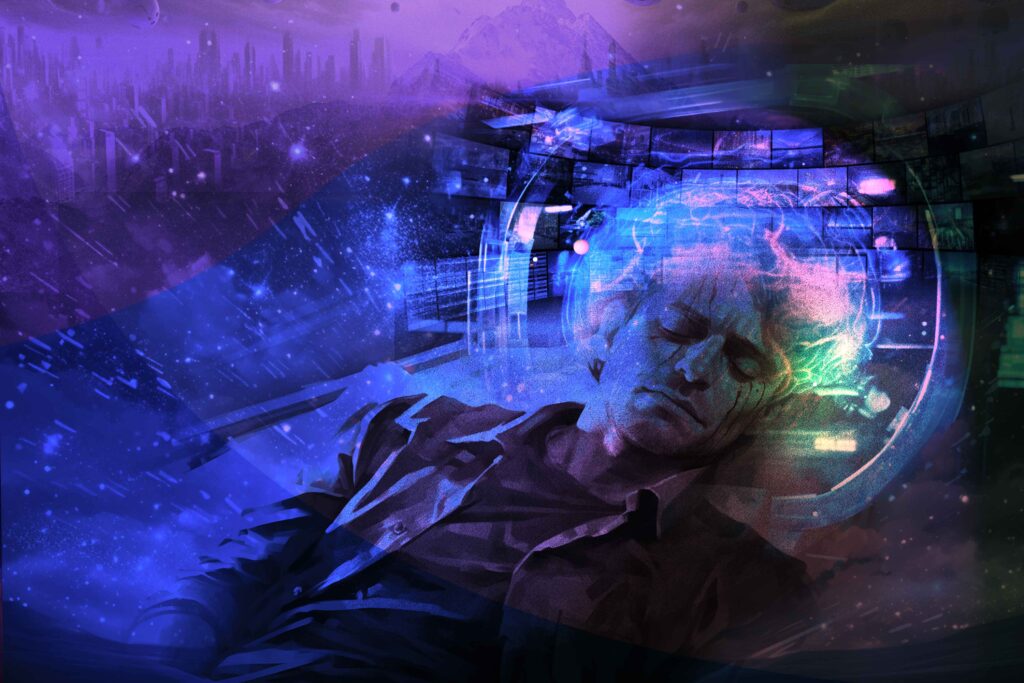
On that day it turned to night, the nights turned to weeks, turned to months, turned to years, and if you can imagine a film scene where the camera speeds up, quicker and quicker, and every speeding second is a year passed as the camera pans out further and further until I’m unseen. You are unable to see me by now yet I’m still here. Stuck, surviving, with no off switch, not as a robot or some soulless machine but as a human. Lying on my stomach face down or with my head turned to one side, unable to die.
In the 1,800 years I have been surviving, I did manage to solve one thing – the pressing question of the meaning of life. Now that I truly understand how profound it is, the irony of being a professor of philosophy and the last human survivor, with so much time to ponder the true meaning behind the question in this situation is beyond comprehension. Irony is an understatement. What I thought the meaning of life was and what it truly is, with so much hindsight and time to think, makes me feel intellectually small when I look back at my old self. My former understanding, of the subject I confidently taught and was so well-known for, was completely wrong. Now that I know what the true meaning is, I have no one to tell and no one to share it with.
The end.
Let us know your thoughts! Sign up for a Mindplex account now, join our Telegram, or follow us on Twitter.
Water Smuggler
Craig sat anxiously on the bus wondering if he would be able to complete his fourth time smuggling water across the border into the United States of America and how much money he could make as soon as this scarce commodity reached the streets. The gradual onset of water scarcity brought about by crippling Climate Change in the latter half of the 21th century and decades of both improper and careless water use had increased the value of fresh water in the second decade of the 22nd century so much so that a liter of fresh and drinkable water possessed a street value comparable to three grams of uncut cocaine. The global scarcity of water had also instigated several devastating wars and the few nations such as Canada that still possessed substantial quantities of fresh water implemented superfluous security measures to safeguard their quantities of this most precious resource.
Presently the United States of America and Canada had an accord in which Canada supplied water in exchange for money or minerals such as cobalt and lithium that Canada sometimes lacked. Many individuals colloquially referred to as water smugglers attempted to capitalize upon the high price of fresh water and would sometimes smuggle water across the border using many ingenious ways. But along with the superfluous security measures that were implemented to protect this resource were harsh laws and if caught a water smuggler could spend up to five years in prison for every one liter of water that was confiscated from them.
Most water smugglers that used private vehicles to transport water sometimes hid it in the trunk, front and rear bumpers or if clever enough in secret compartments in the engine but were eventually caught as private vehicles were more rigorously searched than public transportation by water guards stationed at the border. A group of specialized officers designed to protect water and other resources, especially from leaving the nation without proper authorization.
As the bus stopped at a checkpoint along the border Craig pondered if his usual method of smuggling water would work, wrapped in multiple layers of foul-smelling clothing were five liters of water in two large soda bottles in his backpack. His supplier had gathered it from Lake Superior and he collected it in Toronto hoping that he could make a massive profit as this was the most that he had ever dared to smuggle.
“Open up!” a tall and robust soldier with murderous eyes exclaimed after knocking the stock of his rifle on the door several times.
The driver instantly opened the door after apologizing and the intimidating water guard boarded the bus in his distinct all-black uniform, dark brown boots and beret on which was the emblem of the Water Guard Unit. His heavy boots echoed through the bus as he walked from the front of the bus to the middle and Craig whispered a small hymn hoping that the man would not come to the back. Two other intimidating water guards adorned in the similar clothing then boarded the bus and began randomly searching the belongings of the frightened passengers that sat quietly. They rummaged through the bags and suitcases of the passengers and with loud grunts threw their belongings onto the ground, clearly dissatisfied that they had not found any forbidden items as yet.
A long and cold stream of sweat flowed from Craig’s neck to the base of his back and a few droplets dotted his face and nose. The three heavily armed guards were slowly making their way towards his seat.
Although he was only nineteen years of age, the law would give him no mercy and he could serve 25 years in prison for the amount of water in his backpack. Craig looked frantically around for an exit, maybe an open window or emergency door could avail him if caught? He would have to lighten himself by dropping his backpack but leaving empty-handed would be tremendously better than spending his youth in a prison cell. He became more anxious after realizing that they were no exits and the guards were a few seats before him angrily searching the bags of an elderly couple. He pulled his handkerchief from his pocket, wiped the sweat from his face and readied himself for a potential search.
“What’s in your backpack?” the fearsome guard asked while standing over Craig.
“Some old clothes Sir, I just visited my grandma” Craig answered while masking his nervousness.
“I didn’t ask where you’re coming from, take off the backpack and give it to me” the man instructed and Craig immediately complied.
The other two guards stood behind the man and completely blocked the aisle of the bus while the guard opened Craig’s backpack removing the first layer of musty clothing that were wrapped around the bottles of water. Craig clenched his fist in preparation for a fight, although the man was twice his size he wouldn’t be imprisoned for water smuggling without a fight. Global water scarcity also hindered food output and Craig remembered the horrible stories of many prisoners dying of starvation due to the inability of the prison system to feed them.
“Who the hell comes back from their grandma with dirty clothes, take this crap back!” the guard shouted after throwing the backpack into Craig’s lap and wiping his fingers in his pants in a bid to rid them of the awful smell that befouled them, “I’m not digging through that stink mess any further.”
“Let them through!” One of the guards shouted after they exited the bus.
“Seems like I got lucky again” Craig sighed as he exited the bus and made his way through New York.

The collapse of the many industries that depended on water led to a rapid rise in the cost of living and homelessness. The sidewalks were filled with scores of desperate people that stretched their palms forward, begging for scraps of food or a mug of water. Dressed in dirty clothes Craig was not begged by the desperate scores but he kept vigilant and walked quickly so as to reach home before night when the streets of America turned into areas of savagery where the most barbaric crimes transpired each night.
He was halfway home when he saw angry crowds surrounding one of the water rationing stations that the government had established to provide small amounts to its citizens daily. Apparently, they had finished distributing the allocated amount of water for the day but dozens had received none. Propelled by thirst and survival instincts the swarm of people turned from angry chants to violence, ripping off the tires and metal paneling of the water distribution truck. Craig was sympathetic for the driver and his young assistant that sat in the front seat screaming, this angry crowd would likely exercise their anger upon these two unfortunate men who probably did not have more water to give. This was a regular occurrence and it was clear that society was becoming worse each year as the few large lakes of fresh water and large underground sources slowly diminished.
Craig stood watching the angry crowd and asked aloud, “What would these people do if they found out that I had five liters in backpack?”
Let us know your thoughts! Sign up for a Mindplex account now, join our Telegram, or follow us on Twitter.


.png)

.png)


.png)

